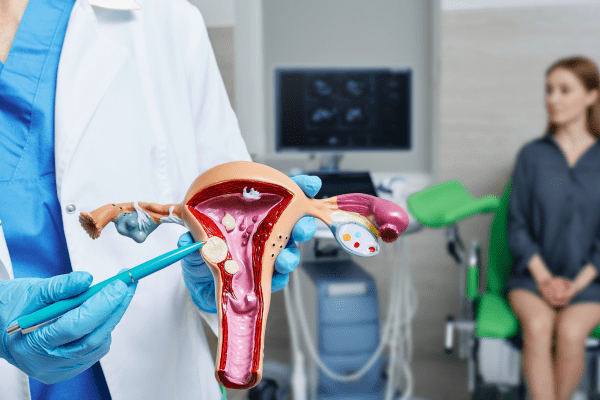Uterine fibroids, also known as leiomyomas or myomas, are noncancerous growths of the uterus that often appear during childbearing years. These common growths can vary in size and quantity, causing symptoms that range from mild to severe. Understanding the treatment options, symptoms, and causes of uterine fibroids is crucial for those affected by this condition.
- Introduction
Uterine fibroids are benign tumors that develop in the muscular wall of the uterus. While they are typically non cancerous, their presence can lead to a range of symptoms and impact reproductive health.
- Causes of Uterine Fibroids
The exact cause of uterine fibroids remains unclear, but several factors may contribute to their development:
– Genetic Predisposition: Family history of fibroids increases the likelihood of their occurrence.
– Hormonal Influence: Estrogen and progesterone, hormones that regulate the menstrual cycle, seem to promote the growth of fibroids.
– Pregnancy: The risk of developing fibroids may be higher during pregnancy due to increased hormone levels.
– Race and Ethnicity: African American individuals are more likely to develop fibroids, and they often experience more severe symptoms.
III. Common Symptoms
Uterine fibroids can manifest with various symptoms, and their severity can vary. Common signs include:
– Menstrual Changes: Heavy menstrual bleeding, prolonged periods, and irregular cycles.
– Pelvic Pain and Pressure: Discomfort or pain in the pelvic region, often accompanied by a feeling of fullness.
– Frequent Urination: Enlarged fibroids can press against the bladder, leading to increased urgency to urinate.
– Backache or Leg Pains: Fibroids can exert pressure on nerves, causing back or leg pain.
– Painful Intercourse: Fibroids can make sexual intercourse uncomfortable or painful.
- Diagnosis
Diagnosing uterine fibroids typically involves a combination of:
– Pelvic Exam: A healthcare provider may detect the presence of fibroids during a pelvic examination.
– Imaging Studies: Ultrasound, MRI, or CT scans can provide detailed images of the uterus, helping to confirm the diagnosis and assess the size and location of fibroids.
- Treatment Options
- Watchful Waiting
For individuals with mild symptoms or those approaching menopause, watchful waiting may be recommended. Monitoring symptoms without immediate intervention allows healthcare providers to assess changes over time.
- Medications
– Pain Relievers: Over-the-counter pain medications can help alleviate discomfort.
– Hormonal Therapies: Birth control pills, hormonal IUDs, or hormone therapy can regulate hormonal fluctuations that contribute to fibroid growth.
– Gonadotropin-Releasing Hormone Agonists (GnRHa): These medications create a temporary menopausal state, reducing fibroid size.
- Non-invasive Procedures
– Uterine Fibroid Embolization (UFE): A minimally invasive procedure that blocks the blood vessels supplying the fibroids, causing them to shrink.
– MRI-Guided Focused Ultrasound Surgery (MRgFUS): Using focused ultrasound waves to heat and destroy fibroid tissue.
- Surgical Options
– Myomectomy: Surgical removal of individual fibroids while preserving the uterus.
– Hysterectomy: Removal of the entire uterus. This option is considered for severe cases or when fertility is not a concern.
- Lifestyle and Home Remedies
Certain lifestyle modifications can help manage symptoms and promote overall well-being:
– Exercise: Regular physical activity can help alleviate symptoms and improve overall health.
– Dietary Changes: A balanced diet rich in fruits, vegetables, and whole grains may contribute to symptom relief.
– Stress Management: Stress reduction techniques, such as meditation or yoga, can be beneficial.
VII. Conclusion
Uterine fibroids are a common condition that can significantly impact the quality of life for affected individuals. Understanding the causes, symptoms, and treatment options is essential for making informed decisions about managing this condition. Seeking medical advice for proper diagnosis and personalized treatment plans is crucial to address individual needs and concerns.
For comprehensive care and fertility-related solutions, individuals can consult with experts like Dr. S. Vyjayanthi, MD, DGO, DNB, MRCOG, MSC (Embryology UK), CCT(UK), at MotherToBe, where a multidisciplinary approach is taken to address the complexities of uterine fibroids and their impact on reproductive health.
FAQs
- Can uterine fibroids be prevented?
– While the exact prevention of uterine fibroids is not known, maintaining a healthy lifestyle, managing stress, and regular medical check-ups may contribute to overall reproductive health.
- Do all fibroids cause symptoms?
– No, many fibroids are asymptomatic and may be discovered incidentally during a pelvic exam or imaging study.
- Can fibroids affect fertility?
– Depending on their size and location, fibroids may impact fertility. Seeking medical advice and fertility specialists can help assess individual circumstances.
- Is surgery the only option for treating uterine fibroids?
– No, there are various treatment options, including medications, non-invasive procedures, and lifestyle changes. The choice of treatment depends on the severity of symptoms and individual preferences.
- Are uterine fibroids cancerous?
– Uterine fibroids are typically non cancerous. However, in rare cases, a cancerous form known as leiomyosarcoma can develop. Medical evaluation and diagnosis are crucial for determining the nature of the growth.

